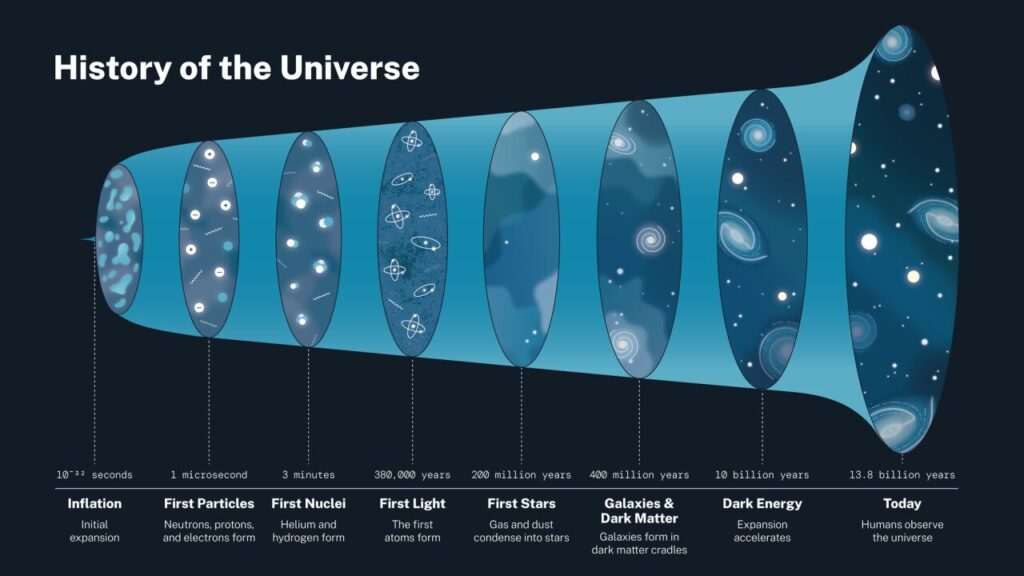
The universe, an eternal enigma, may soon reveal new secrets as recent observations suggest dark energy is evolving. This groundbreaking discovery, made by an international research team using the South Pole Telescope, could potentially inspire a new model of the universe. The findings, which cover two years of data collection, offer sharper insights into the nature of dark energy and the universe’s expansion rate.
The research team, stationed at the Amundsen-Scott South Pole Station in Antarctica, has been mapping the infant universe over 1/25th of the sky. Their observations have significantly enhanced our understanding of dark energy, a mysterious force that constitutes nearly 70% of the universe and influences its expansion.
The Big Bang and the Current Cosmological Model
The universe’s journey began approximately 13.8 billion years ago with the Big Bang, a primordial explosion that marked the birth of everything we know. The prevailing model, known as the “hot Big Bang,” describes the universe’s early state as a super-heated plasma, similar to the sun, composed of photons, electrons, and ionized hydrogen and helium nuclei.
As the universe expanded and cooled, this plasma recombined to form atoms. Modern telescopes can detect the cosmic microwave background (CMB), a faint radiation from 400,000 years after the Big Bang, offering a snapshot of the universe at that time. The Lambda-CDM model, our best cosmological framework, suggests that dark matter collapses to form dense regions, pulling in ordinary matter to eventually create galaxies and stars.
Dark Energy: The Mysterious Force
Dark energy, first invoked in 1998 following observations of distant supernovae, is believed to be responsible for the accelerated expansion of the universe. Unlike matter, which attracts, dark energy repels, acting almost like an “anti-gravity.” Einstein’s cosmological constant, initially introduced to maintain a static universe, was later revived as a potential explanation for this acceleration.
The South Pole Telescope’s recent findings, in conjunction with data from the Dark Energy Spectroscopic Instrument (DESI), suggest that dark energy may be weakening over time. This revelation challenges the notion of a cosmological constant and hints at a more dynamic, time-evolving dark energy model.
New Observations and Their Implications
The South Pole Telescope, equipped with 16,000 detectors sensitive to millimeter-wavelength light, has provided precise measurements of the CMB’s temperature and polarization patterns. These observations, combined with DESI’s 3D galaxy distribution data, indicate that dark energy’s influence might diminish in the future, potentially halting the universe’s accelerated expansion.
“The improved measurements from the South Pole Telescope, when combined with the DESI experiment and other CMB datasets, reduce the likelihood of a cosmological constant and increase the preference for time-evolving dark energy models.”
This development could necessitate updates to our cosmological models, particularly concerning the sound horizon scale from 13.8 billion years ago. The significance of these findings is further bolstered when supernova observations are included.
Revisiting Einstein’s Theory of Relativity
Einstein’s theory of relativity, formulated in the early 20th century, originally included a cosmological constant to support a static universe. However, after the discovery of the universe’s expansion by Edwin Hubble in 1929, Einstein abandoned this concept. The subsequent discovery of the universe’s accelerating expansion led to the revival of the cosmological constant as a repelling force.
Current evidence suggests that we may need to move beyond this constant. If dark energy is indeed evolving, it could imply necessary modifications to general relativity or the inclusion of new physics to account for a dynamic dark energy.
Future Research and Expectations
While the current evidence for evolving dark energy is compelling, it falls short of the gold standard required for definitive scientific acceptance. The DESI collaboration plans to upgrade its instrument, DESI-2, and aims to develop a more ambitious spectroscopy experiment, Spec-S5. Additionally, an upgraded receiver for the South Pole Telescope is anticipated in 2028, alongside upcoming results from the Simons Observatory and the CMB-S4 experiment in the 2030s.
“Sometime along this track, we will hopefully have enough evidence to definitively say if the accelerating expansion of the universe is truly losing steam.”
As these projects progress, the scientific community eagerly awaits further confirmation of evolving dark energy, which could redefine our understanding of the universe’s future.





